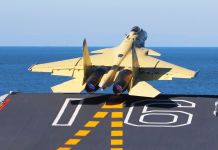Iran is spending millions of dollars to deploy its domestic equivalent of the S-400, the Bavar-373 air defense system in Syria, to protect its assets from Israeli air strikes, according to the latest reports.
The Sayyad-4B missile, assessed to have a range between 250-300 kilometers, combined with the Bavar-373 AD platform, can reportedly track and engage Israel’s US-origin F-35 stealth fighters.
Israel uses the specially designed ‘I’ version of the F-35 and has rechristened it as Adir.
Odd Syrian Situation
Israel has often hit Iranian targets in Syria, which it says poses a threat to Israeli security as its militias in the war-torn country support President Basher al-Assad, an Israeli rival.
Iran and Russia are Syrian allies that backed Assad in the civil war that erupted in 2011. Many rebel groups in the umbrella Free Syrian Army (FSA) were linked to Al-Qaeda and AQ-affiliates Al-Nusra Front and Jabhat al-Nusra.
The US, Israel, and Turkey supported the protestors, with Iran using its Shia militias to protect its and Assad’s interests. These militias are accused of having links with the Lebanese Hezbollah, which Israel fears can launch a joint strike against it and periodically conducts aerial bombing raids against them inside Syria.
Interestingly, these strikes are conducted with tacit Russian approval as a part of a deconfliction mechanism with Israel, allowing both countries to exercise their security interests, which ironically doesn’t impact Russia-Iran relations.
Tehran understands Russia has to maintain its ties with Israel and doesn’t perceive it as Moscow giving it up for Jerusalem. On the contrary, Russian air defense systems like the Tor and Buk in Syria often shoot down incoming Israeli air-to-ground missiles and wield their capability to track Israeli aircraft every time Israel escalates against Iran and has it cornered.

Israel last conducted strikes on Damascus in March 2022, Tartus in July 2022, and two strikes in Homs in November and December 2022.
But with the war in Ukraine entering another year and possibly wanting to relieve some load off Russian military platforms that might have to be taken to Europe and the hardline Benjamin Netanyahu returning as Israel’s Prime Minister, Iran presumably wants to strengthen its defenses inside Syria.
Iran Wants To Take On Israeli Strikes In Syria
Reports quoted Iran shifting its strategy to “promote the deployment of aerial defense capabilities on its behalf in Syria at the cost of tens of millions of dollars to deal with the Israeli airstrikes.”
These defense capabilities will also have an option for “independent Iran operation” of the air defense systems, apart from its collaborative nature with the Syrian Arab Army (SAA).
Iran believes the Israeli air strikes often risk Syrian military personnel, which would cause diplomatic complications, and therefore prefers the control of its air defense system by its personnel in the long term.
F-35s Versus Iranian And Russian Radars
Iranian officials have long boasted that the Bavar-373 is comparable to the Russian S-400 and the American Patriot and Terminal High-Altitude Air Defense (THAAD) missile systems.
In November, an upgraded Bavar-373 version reported a detection range of 450 kilometers and a tracking range of 400 kilometers.
Iran’s Tasnim news agency quoted the Islamic Republic of Iran Air Defense Force (IRIADF) Brigadier General Alireza Sabahifard, who said the missile’s maximum altitude had been increased from 27 to 32 kilometers and a target drone was destroyed at the height of 40,000 feet.

Israeli F-35 fighters were last reported to have crossed into Iranian air space in 2021, according to a report in Saudi news outlet Elaph in August 2022.
Israel was preparing with the United States to strike Iran if the talks on the Iran nuclear deal failed. These were part of massive Israeli exercises in the Red and Mediterranean Seas to prepare for a war with Iran and work out ways to penetrate its air and coastal defenses.
That Iran did not protest the Israeli F-35 overflights means it failed to detect them, and the stealth aircraft did, at the time, manage to evade powerful Russian and Iranian radars.
Before that, in June, however, Russian media claimed that its powerful Electronic Warfare (EW) systems disrupted Israeli F-35s’ targeting systems that failed to strike ground targets during a military demonstration before the country’s top leadership, which included then Prime Minister Naftali Bennett.
- The author can be reached at satamp@gmail.com
- Follow EurAsian Times on Google News




